Alt Text vs Image Caption, What’s the Difference

Most bloggers upload images and move on. They focus on the picture itself and forget the small details that sit around it. But those details matter more than people think. They influence how readers move through your content, how easily they understand your message, and how search engines interpret your page. Alt text and image captions are two elements that deserve more attention. They look simple, but they do important work behind the scenes. If you want a deeper understanding of alt text, you can read my blog on why alt text matters and how to get it right. Alt text helps people who cannot see the image and helps search engines understand what the image shows. Captions guide readers who can see the image by adding quick context and pointing out what matters. When you use both the right way, your content feels clearer and more thoughtful. It becomes easier to read, easier to skim, and more accessible for everyone. These small additions also support better structure because they help readers move smoothly from one idea to the next. TL;DR Alt text is hidden descriptive text that helps screen readers and search engines understand your image. Captions are visible text below an image that help readers understand what they are seeing. Both matter for clarity, accessibility, and user experience. Alt text supports accessibility while captions guide readers who can see the image. What Alt Text Really Does Alt text is useful when the reader cannot see the image. This could be due to a broken image, slow loading, or because the person is using a screen reader. Alt text gives the essential meaning so the reader does not miss the point. Search engines also rely on alt text. It helps Google understand the image context and match it to relevant searches. This improves accessibility and SEO at the same time. Good alt text avoids decorating the sentence. It focuses only on the essential visual information. A simple description often works best. Alt text stays hidden, while captions always sit in the open. What Image Captions Do Captions are visible to every reader. They sit under the image and guide the reader by adding context. They can explain the purpose of the image, point out a detail, or support the paragraph around it. Captions improve readability and help with flow. Many readers scan captions before reading the full article. A clear caption helps them understand the importance of the image at a glance. Captions do not have strong direct SEO value, but they help with user engagement. Better engagement supports overall search performance. Alt text works behind the scenes and captions appear in the live view. Differences Between Alt Text and Image Captions A simple table for clarity. Point of Difference Alt Text Image Caption Purpose Explains the image when it cannot be seen Supports the image when it is visible Visibility Hidden within the HTML tag Shown under the image SEO Role Helps image search and ranking signals Helps readability and engagement, low direct SEO Accessibility Required for accessible content Optional, not required Writing Style Short, simple, factual Conversational and flexible Placement Inside the image tag In the article body Detail Level Essential meaning only Can include extra context Search Appearance Helps with Google Images Appears in article content only When It Appears When image fails to load or via screen reader Always visible Audience Screen readers and search engines Human readers Using both strengthens your content. Alt text helps with accessibility and SEO. Captions help guide the reader and make your article smooth to read. Together, they improve the structure and clarity of your blog. Bloggers use both alt text and captions to make images easier to understand. How to Write Good Alt Text Good alt text is simple, clear, and meaningful. It focuses on the message the image is supposed to convey, not on making the description fancy. You are writing for someone who cannot see the image, so clarity matters more than creativity. Start by identifying the purpose of the image. Ask yourself what message the reader should understand from it. Your alt text should reflect that purpose in plain language. Be specific but avoid over-describing. Mention details only if they help the reader understand the image better. Skip colors, emotions, or guesses unless they are important to the message. Keep your sentences short. You are not writing a caption. You are giving essential information to someone who depends on it to understand your content. Here are a few guidelines that help: Describe only what matters. If the image is decorative, leave the alt text empty. Avoid phrases like “image of” or “picture of.” Screen readers already know it is an image. Use keywords only when relevant. Never force a keyword; it weakens accessibility. Match the image to the article’s context. If the picture is part of a tutorial, describe the step or action. Think of it like reading the image aloud. Simple, natural language is always better. Example: Instead of “a beautiful woman working happily on a laptop at a stylish cafe” Try “woman typing on a laptop at a cafe table” The second version is factual, simple, and avoids assumptions about emotions. Good alt text supports both accessibility and search visibility. It also keeps your writing clean and helpful. How to Write Good Captions Good captions help your readers understand why the image is in your blog. They don’t repeat what the photo shows. Instead, they add clarity or context. Start by pointing out what the reader should pay attention to. If the image supports a point in your post, the caption should highlight that point. It helps the reader make the connection between the image and the message. Keep your captions short. One or two lines work best. Long captions interrupt the reading flow. Captions can add tone or personality. In a personal blog, they can feel warm. In an educational blog, they can give a quick hint or explanation. The goal
What Not to Write in Listicles
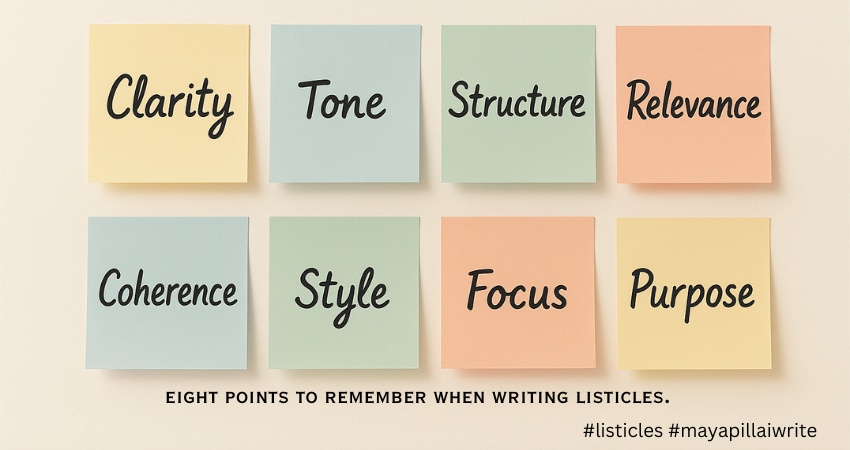
Writing listicles isn’t just about numbering ideas. It’s about structure, clarity, and value. This guide covers eight simple things to remember when writing listicles so your content stays readable, engaging, and relevant — without the fluff or repetition that turns readers away.
How to Optimize Anchor Text for SEO
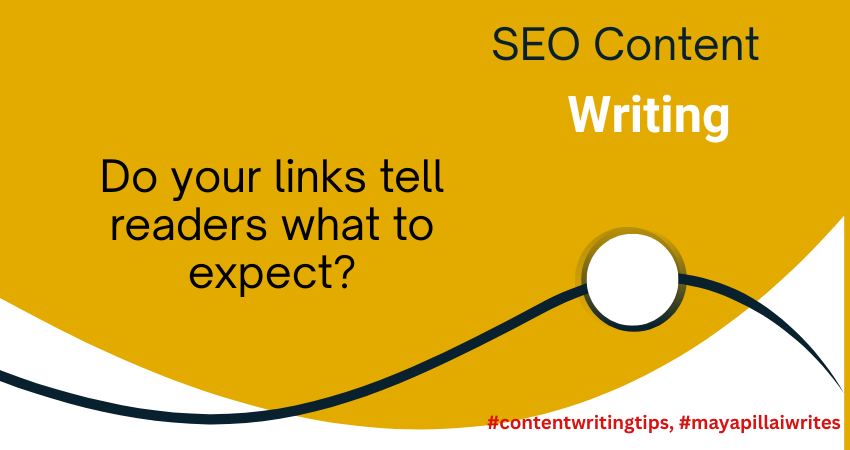
If you write online, you’ve probably added links to your articles. But the words you choose for those links — known as anchor text — matter more than most you realize. Anchor text is the clickable part of a hyperlink, and it tells both readers and search engines what to expect on the other side. When done right, anchor text improves SEO, makes your writing more reader-friendly, and helps your content rank. When done poorly, it can confuse readers and even lower your site’s visibility. In this article, you’ll learn how to optimize anchor text for SEO in a way that feels natural and easy to apply to your writing. This article is written from the writer’s perspective than from that of a SEO person. TLDR Anchor text is the clickable text in a link, and optimizing it improves SEO, readability, and user experience. Use descriptive and natural phrases, vary your wording, and link contextually within your content. Internal linking optimization keeps your site connected, while backlink anchor text builds authority. Regular anchor text audits ensure balance, and scaling practices help writers maintain consistency. Importance of an Anchor Text Anchor text SEO isn’t about tricking Google. It’s about being clear and helpful. If you use vague anchors like “click here” or “read more,” readers don’t know what they’re clicking on. If you stuff keywords into every link, it looks spammy and unnatural. If you use descriptive, natural anchor text, readers get value and search engines understand your content better. For writers, anchor text SEO is a skill that makes your work look more professional and improves discoverability. Internal Linking Optimization Internal linking optimization is linking between your own blog posts, portfolio pieces, or website pages. It keeps readers exploring your work and helps search engines connect your content. Match the anchor to the page topic If you wrote a guide on building a freelance portfolio, don’t just link with “portfolio.” Instead, use how to create a freelance writing portfolio. It signals exactly what the reader will get. Be descriptive, not vague Instead of “read more,” write anchors like learn how to optimize anchor text. Descriptive anchors improve trust and clicks. Use natural variations If you always link with the same phrase, it feels robotic. For example, mix backlink anchor text, anchor text for backlinks, and how backlinks work. Variations make your writing more natural. Spread anchors across your site Don’t always use the same anchor for one post. Use different but related phrases so your content captures multiple search terms. Link from stronger posts If one of your articles ranks well, link from it to a new post using optimized anchor text. This passes authority and helps the new post grow. Keep links in-context A link inside a paragraph is more powerful than one in a sidebar or footer. Always link within sentences that flow naturally. Backlink Anchor Text Backlink anchor text is what other sites use when they link to you. As a writer, you can’t fully control this, but you can guide it. Don’t over-optimize If too many sites link to you with the exact phrase anchor text SEO, it looks unnatural. Balance it with branded and partial matches. Suggest variations when guest posting If you’re writing a guest blog, suggest multiple anchor options. For example: internal linking optimization tips, backlink anchor text explained, or anchor text SEO guide. Blend brand and keyword anchors For your own site, try combining your name or brand with keywords, like Maya Pillai’s guide to anchor text SEO. It makes the link authentic. Avoid spammy anchors Low-quality sites may link with irrelevant words. These can hurt your profile. If possible, ask for changes or ignore them. Closing Paragraph Optimizing anchor text isn’t about following rigid SEO tricks; it’s about writing with clarity and intention. As a writer, you’re already choosing words carefully for your audience. Anchor text SEO is simply another layer of that craft. When you use descriptive, natural anchors and apply internal linking optimization consistently, your writing not only flows better but also gains visibility. Over time, this small habit can turn into a powerful strategy that strengthens your content and helps you stand out online. FAQs What is anchor text SEO? Anchor text SEO is the practice of using clear, descriptive words for hyperlinks so that both readers and search engines understand the linked page. How to optimize anchor text without keyword stuffing? Focus on natural language. Use variations like partial matches, branded anchors, and related terms instead of repeating the same keyword every time. Why is internal linking optimization important for writers? Internal linking optimization connects your articles, helps readers explore your content, and passes authority to key pages, which boosts rankings. What is backlink anchor text and why does it matter? Backlink anchor text is the clickable text used by other websites when linking to your content. Natural and varied backlink anchors strengthen your SEO profile. How often should I do an anchor text audit? Running an anchor text audit every few months helps you spot overuse, irrelevant anchors, or spammy links. This keeps your profile balanced and trustworthy.
How to Write a TL;DR
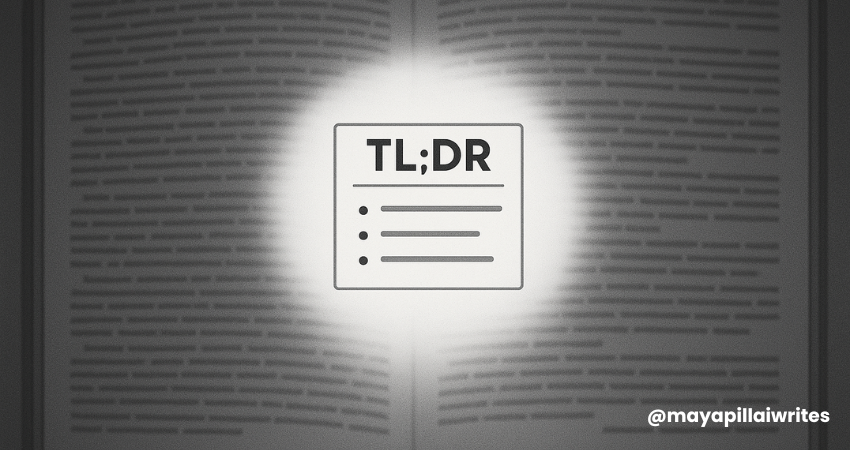
Most people don’t read every word on a page. According to the Nielsen Norman Group, users typically read only 20–28% of the text during an average visit. Add to this the reality that mobile readers scroll even faster, and you can see why summaries matter. A TL;DR (Too Long; Didn’t Read) gives readers the gist of your content in seconds. It keeps busy professionals from bouncing away and signals search engines that your article is structured, clear, and helpful. In the age of AI-powered search results and Google’s SGE (Search Generative Experience), TL;DRs have become even more powerful. They help your content get picked up for answer boxes, voice search, and AI-generated snippets. If you want your content to rank and resonate, you need a TL;DR that does more than summarize. It should hook readers, highlight value, and improve your visibility in search. Here are 10 practical tips on how to write a TL;DR that works for both people and algorithms. TL;DR Tips to Write TL;DR A TL;DR condenses your content into under 100 words. Write it last so it reflects the full piece. Use short sentences or bullets for clarity. Highlight reader value, not every detail. Place it near the top for maximum impact. Add focus keywords naturally for SEO and SGE. Match your article’s tone. Adapt TL;DRs for blogs, social, and reports. Test formats to see what performs better. Treat it as a hook, not an afterthought. Key Takeaways A TL;DR is not optional — it’s essential for both readers with short attention spans and search engines (especially AI-driven ones like Google SGE).Always write it last so it reflects the true essence of your content. Keep it short and direct — under 100 words, ideally 2–3 sentences or 3–5 bullets. Focus on reader value, not details — answer “what’s in it for me?” Use bullets or short sentences to make it scannable. Place the TL;DR near the top of the article, right after the intro. Add your focus keyword naturally for SEO and AI search visibility. Match the tone of your content so it feels consistent. Adapt it for platforms — bullets for blogs, conversational for LinkedIn, one-liners for Threads/X. Test and refine different formats; track engagement and adjust. Treat the TL;DR as a hook and pitch, not an afterthought. 10 Practical Tips to Write TL;DR 1. Write the TL;DR Last You need to understand your content fully before summarizing it. Writing the TL;DR after finishing your piece helps you capture the most important takeaways, not just what you think is important at the start. Think of it as writing the back-cover blurb of a book—you wouldn’t draft it before finishing the story. 2. Keep It Under 100 Words Readers want a quick grasp, not another mini-article. Aim for 2–3 sentences or 3–5 bullet points. Anything longer loses the “instant clarity” effect. On mobile, your TL;DR should fit on one screen without scrolling. Conciseness makes it powerful. 3. Focus on Reader Value Don’t summarize everything. Instead, answer the reader’s main question: What’s in it for me? Highlight the key outcomes, benefits, or lessons. If your blog is about writing productivity, your TL;DR should say, “These tips will help you write faster without losing quality” instead of simply stating that the article “lists productivity tools.” 4. Use Bullets for Clarity Bullets make TL;DRs easy to skim. They also break down points visually, so readers can digest them at a glance. If your article has multiple sections, bullets give structure without overwhelming. For long-form posts, this format is especially effective. 5. Place It at the Top A TL;DR works best right after your introduction. This is where readers decide whether to stay or leave. By placing it near the top, you show respect for their time and increase engagement. Search engines also give weight to summaries that appear early in the text. 6. Add Keywords Naturally For SEO and SGE, weave your focus keyword naturally into the TL;DR. For example, if your post is about how to write a TL;DR, make sure that phrase appears once in the summary. Don’t overstuff; keep it natural and conversational. Keywords here help search engines understand your content quickly. 7. Match the Tone of the Content If your article is casual, your TL;DR should be too. If it’s professional and research-driven, keep it crisp and precise. Consistency builds trust and makes the summary feel like an extension of the article, not a separate add-on. 8. Adapt It for Platforms Not every TL;DR looks the same. On a blog, bullets work well. On LinkedIn, you can expand it into 3–4 conversational sentences. On X (Twitter), shrink it into one sharp one-liner. By tailoring your TL;DR, you make your content reusable across platforms without feeling repetitive. 9. Test Different Formats Experiment with different styles—bullets vs. short paragraphs, one-line vs. multi-sentence. Check your analytics for scroll depth, bounce rate, and engagement. If your TL;DR is doing its job, you’ll see people spending more time on the page and scrolling deeper. If not, refine it until you find what resonates. 10. Treat It as a Hook, Not an Afterthought A TL;DR is more than a summary. It’s a pitch to convince readers your article is worth their time. Don’t tack it on quickly. Spend a few minutes refining it, because it may end up being the most-read part of your piece. Think of it as your first impression—make it count. Quick FAQs Q1. What is a TL;DR in writing? A TL;DR is a short summary that highlights the key points of an article, report, or post. It helps readers get the main message quickly without reading the entire text. Q2. How long should a TL;DR be? A TL;DR should be under 100 words. Keep it to 2–3 sentences or 3–5 bullet points so readers can understand it in seconds. Q3. Where should I place a TL;DR in a blog? Place your TL;DR near the top, usually after the introduction. This helps readers decide whether they want to
TL;DR in Content: How to Engage Readers and Rank Better
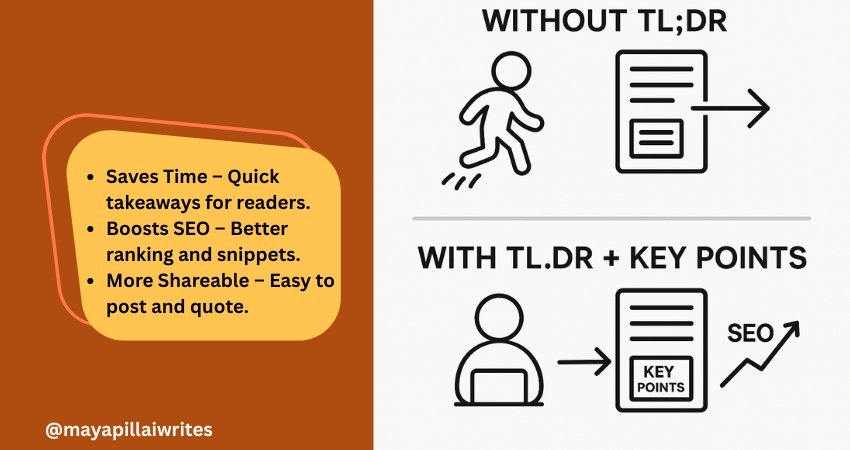
Including a TL;DR in content is no longer optional. Readers skim, AI search engines summarize, and attention spans keep shrinking. A TL;DR(Too Long; Didn’t Read) gives a quick summary that respects your readers’ time and makes your blog easier for AI tools and Google’s Search Generative Experience (SGE) to surface. But a TL;DR alone isn’t enough. Adding Key Points beneath it ensures that both skimmers and detail-seekers get value. In an era where AI decides what parts of your content get shown, these two elements can set your blog/article apart. TL; DR A TL;DR in content is a short summary that captures your article’s main idea. It helps readers, AI tools, and search engines understand your blog quickly. Key Points expand on the TL;DR with detailed highlights, giving both readers and AI more context. Using both together improves readability, SEO performance, AI search visibility, and builds trust with your audience. Key Takeaways A TL;DR isn’t just a convenience — it’s a strategic tool that improves both user experience and how AI-driven search engines interpret your content. Key Points aren’t filler; they strengthen SEO by adding structure, making your blog more likely to rank for related queries and appear in featured snippets. Pairing TL;DR and Key Points bridges the gap between human readers and AI systems, ensuring content is engaging, scannable, and machine-readable at the same time. In long-form blogs, Key Points can double as jump links for better navigation, which is especially important for mobile readers. Respecting reader time with a TL;DR and guiding them with Key Points ultimately builds trust and authority, which pays off in both engagement and search rankings. What is TL;DR in Content? TL;DR is a short summary that captures the core message of your article. Usually placed right after the introduction, it helps readers and AI tools quickly understand what the content is about. Why it’s important now: Readers want speed Most online readers don’t have the patience to go through long paragraphs before deciding if something is worth their time. A TL;DR gives them the headline takeaways immediately, allowing them to judge whether to continue reading. Without it, you risk losing them before they get to your key message. AI favors clarity Search engines and AI-powered tools are built to pick up well-structured summaries. A TL;DR written in simple, direct language makes it easier for these systems to surface your blog in snippets, SGE cards, and chat-based search results. This increases your visibility without extra effort. Boosts visibility Blogs with a TL;DR have a higher chance of being featured in “People Also Ask” boxes or summary snippets. Search engines look for clear, condensed content they can repurpose quickly, and a TL;DR is ready-made for that. Improves shareability Readers who find value in your TL;DR are more likely to copy it into a LinkedIn post, share it in a newsletter, or use it as a quote in their own content. This creates organic backlinks and visibility for your blog. Voice search ready Voice assistants like Alexa and Google Assistant prefer short, straightforward answers. A TL;DR formatted in 2–3 sentences naturally fits the length of a spoken response, which makes your blog more discoverable in voice search results. Mobile-first reading On small screens, people scroll faster and often skim through headlines only. Having a TL;DR upfront ensures your blog’s value is captured in the first screen view, even if the reader doesn’t scroll further. Trust-building By offering a summary upfront, you show readers you respect their time. It also signals confidence in your content — you’re not hiding the main message in walls of text. This creates trust and makes readers more likely to return to your blog. Supports accessibility Not all readers consume content the same way. For people with attention difficulties or those using screen readers, a TL;DR provides a simple entry point that ensures they still get value from your writing. What are Key Points? Key Points are a set of bulleted highlights that expand slightly beyond a TL;DR. While TL;DR gives the big picture, Key Points provide a roadmap of what’s inside the article. Why they’re valuable in the AI era: Act as signposts Many readers jump around instead of reading blogs linearly. Key Points act like a table of contents in miniature, showing readers what the article covers. This keeps them on your page longer because they know exactly what to expect. Strengthen SEO Search engines like Google prioritize structured content. Bullet lists with concise explanations often show up in featured snippets and “zero-click” results. By using Key Points, you give your blog multiple chances to rank for related queries, even if the reader never clicks through. Support AI summaries AI-driven platforms, including Google SGE, scan content for structured data they can repurpose. Well-written Key Points make it easier for these systems to understand your blog’s scope and deliver accurate summaries, increasing your chances of being displayed in answer cards. Increase retention When readers see clear Key Points, they know the content is organized. This makes them more likely to stay on your blog and read further. A messy block of text, in contrast, often leads to higher bounce rates. Add clarity for busy readers Some people want more than a one-line TL;DR but don’t have time for the full article. Key Points give them the middle ground: detailed highlights that still save time. It’s a way of serving both casual readers and more serious ones at the same time. Improve content navigation In long-form blogs, Key Points can be turned into clickable jump links. This is especially helpful for mobile readers, who don’t want to keep scrolling endlessly to find one section. It improves usability and keeps them engaged. Build authority Presenting your highlights clearly at the start shows confidence in your insights. It signals that you know your subject well enough to extract the main lessons upfront, which builds trust with both human readers and AI tools. TL;DR vs Key Points: Why You Need Both You might wonder, “If I already
How to Write Listicles That Actually Work

Writing listicles might seem like a small thing, but if you’ve ever written a blog that felt cluttered or confusing, you already know the value of structure. Listicles solve that problem. They break big ideas into clear steps and help your writing feel more focused from start to finish. They bring structure, make information easier to absorb, and keep the reader moving through the content without getting lost. If you’re still not sure what qualifies as a listicle, start here: What is a Listicle? Key Takeaways Listicles improve structure and readability Each list item should serve one clear purpose Add your voice and end with a soft CTA This blog will show you how to write listicles that are simple, useful, and worth reading. 1. Pick a Topic That Naturally Splits Into Parts Don’t force a list format. Choose something that breaks easily into tips, steps, or points. Examples That Work: “7 Mistakes Freelance Writers Make” “5 Tools Every Blogger Should Use” “10 Ways to Build a Personal Brand Online” Avoid abstract topics like “What is creativity?”—they’re harder to break into points. Want to know why this format performs so well? Read: Why Listicles Work Well 2. Use Numbers in the Title Numbers signal clarity. They tell the reader exactly what to expect. Odd numbers tend to feel more natural, but even numbers work fine if the content delivers value. Examples: “11 Writing Tools That Save Me Hours”“9 Tips for Building Your Writing Routine” “3 Simple Fixes for a Weak About Page” Avoid vague titles like: “Everything You Need to Know About Writing” This gives no sense of structure or value. 3. Start With a Short, Honest Intro Don’t build up too much. Get straight to the point. Example Intro: I struggled with writing blogs that people would actually read. Once I started using listicles, things changed. Here’s what helped me make better content. A simple story or moment of clarity works better than a generic statement. 4. Use Clear Subheadings for Each Point Your subheadings are the anchors. They help readers skim, jump, pause, and resume without confusion. Example: 4. Use Subheadings to Guide the Reader Readers don’t read every word. Subheadings let them find what they need quickly. Listicles support fast reading habits and help with page structure. To understand how this improves UX, check out: How Listicles Improve Readability in Online Content 5. Keep the Flow Tight Listicles aren’t about dumping thoughts into numbered format. Each point should cover one idea clearly. Good Example: a) Use Simple Language Avoid jargon unless your audience expects it. Write like you’re talking. It makes content easier to follow. Bad Example: b) How to Write and Edit While Formatting and Optimizing for SEO This is doing too much. Break this title into 2 articles for better clarity. 6. Add Your Voice Let the reader hear you. Use your tone, even if the format is structured. Example: I once thought listicles were lazy writing. But then one of mine brought in more traffic than anything else that month. Turns out, structure works. Use stories, opinions, or short tips that sound like something you’d actually say. 7. Close with a Nudge Don’t end at the last point and walk away. Wrap things up with a quick thought or question. Examples: Which of these tips are already part of your process? Got a favorite way to write listicles? I’d love to hear it. This encourages comments, bookmarks, or shares without a hard push. To Sum Up Listicles aren’t shortcuts. They’re focused writing. They help you stay on track, break down ideas, and deliver clarity. If you’re building a blog or writing for clients, knowing how to write listicles gives you a format that’s fast to write and easier to read. And that makes both you and your reader happy.
Why Listicles Work Well

Listicles work well, and I’ve seen that firsthand. When I started using them in my blog posts, I noticed something shift—higher clicks, longer time on page, and more reader interaction. The same content in a standard paragraph format didn’t get the same results. That’s when I realized this format isn’t just convenient. It’s effective. It’s not about being trendy or lazy. It’s about writing in a way people want to read. Times have changed; the attention span of the people are short and competition is everywhere, listicles help your content stand out. Key Takeaways Listicles increase clarity, retention, and engagement. They are SEO-friendly, easy to update, and user-first. Great for both blogs and client content, especially in crowded niches. If you’re new to this format or wondering what exactly qualifies as a listicle, check out this detailed guide on what a listicle is. 9 Benefits of Listicles That Make Them Work So Well Easy to scan People rarely read full blog posts word for word. They scan for key information. Listicles present data in a format where readers can easily find what they need without committing to the entire article. Each point works as a mini-topic, making it easier to digest. Improves readability Readability directly affects user experience and bounce rate. By breaking content into bite-sized segments with clear headers and white space, listicles reduce visual fatigue. This makes it easier for readers to focus and retain information. Drives higher engagement Every list item invites continued reading. A well-crafted listicle encourages scroll behavior, which improves session duration and user interaction. If readers stay longer, they’re more likely to click internal links, comment, or share the post. Enhances SEO performance Search engines favor structured content. Listicles often secure featured snippets because the numbered format aligns with how Google parses direct answers. They also allow for strategic keyword placement without overstuffing. Fits search intent better Listicles align with the way users phrase queries—”top 10 tips for…” or “ways to…” This direct alignment improves relevance, which boosts click-through rates. Users want quick, actionable answers, and listicles deliver just that. Easier to update Unlike narrative posts, updating a listicle is simple. You can add new points, remove outdated ones, or revise sections without disrupting the entire flow. This helps maintain freshness and relevance, both of which impact SEO. Higher shareability Social media users prefer sharing content that’s concise and actionable. Listicles get more traction on platforms like LinkedIn, X (formerly Twitter), and Facebook because they are easy to quote, comment on, or summarize. Builds trust Well-organized content signals authority. When each point is backed with examples, stats, or tools, readers trust the information more. This trust increases the likelihood of return visits and conversions. Works across niches Whether it’s tech, travel, writing, or personal finance, listicles adapt. They can present how-tos, recommendations, mistakes to avoid, or trend roundups with equal efficiency. 10 Psychological Reasons Why Listicles Work Listicles don’t just perform well because of formatting. They tap into how our brains are wired to consume information. Here’s why they connect so strongly with readers: Predictability Knowing how many points to expect gives the brain a roadmap. If a list promises 10 tips, readers feel more confident committing to the article. Progress tracking Each completed point feels like progress. That subtle sense of accomplishment keeps people scrolling through to the end. Chunking of information We process data more efficiently when it’s broken into chunks. Listicles support this by separating ideas into bite-sized segments. Reduced decision fatigue A long article with no structure can feel overwhelming. A numbered list reduces the choices a reader has to make by offering clearly marked options. Cognitive ease The brain prefers simplicity. Listicles use repetition and consistency, making the reading experience smoother and more enjoyable. Anticipation and curiosity Each new item creates a small hook: “What comes next?” That micro-curiosity keeps readers engaged longer. Emotional reward Completing a list gives a small dopamine boost. Readers feel like they’ve “ticked something off,” even when passively consuming content. Visual scanning With numbered points and bold subheads, listicles are easy on the eyes. The design mirrors how people skim content, especially on mobile. Reduced bounce rates Since readers know what to expect and can move through content quickly, they’re less likely to exit mid-scroll. Mental shortcuts People rely on heuristics to make fast decisions. A numbered list feels more credible and authoritative, helping users choose your article over others. There’s a reason we prefer lists over blocks of text. It’s not just style—it’s psychology. Predictability: Knowing there are 7 or 10 items gives a clear mental map. Progress tracking: We feel a sense of accomplishment as we move down the list. Chunking: Our brains process information better in groups. Lists use this to their advantage. This structure plays a key role in retaining attention and improving content recall. Effective listicles usually share three traits: A strong promise in the title Well-researched, actionable points Clean, skimmable layout Whether it’s “5 Security Tools for Small Businesses” or “7 Mistakes to Avoid When Hiring a Writer,” high-performing listicles solve real problems in a focused way. To Sum Up Listicles work well because they make information more accessible. They suit how people read today—fast, distracted, and results-oriented. They’re not about cutting corners; they’re about delivering more value in less time. If you’re looking to increase reach, engagement, and conversions, the listicle format deserves a spot in your content strategy. CTA Want high-performing listicles for your business or client blogs? Let’s collaborate or browse more writing strategies at mayapillaiwrites.com.
Why I Stopped Saying “Can You” to ChatGPT (And You Should Too)

I used to treat ChatGPT like a human. I’d write things like, “Hi ChatGPT, can you please help me write a short blog post?” Or “Would you mind giving me some ideas for social media content?” Sound familiar? It felt natural to be polite. After all, we’re wired to be courteous—even to machines. But here’s what I’ve learned after months of using generative AI tools like ChatGPT, Claude, and Gemini in my daily writing work: Politeness slows things down. Worse, it confuses the AI and leads to vague or irrelevant results. This isn’t just a personal opinion. According to reports, adding unnecessary polite language is also increasing processing costs for AI companies. OpenAI, for example, spends millions of dollars more in server energy because users are inputting long-winded or vague prompts. So if you want sharper, faster, and more accurate results from your AI tools, drop the fluff and get to the point. Key Takeaways Skip the Politeness Avoid phrases like “can you” or “please” — they confuse AI and reduce response accuracy. Be Direct and Specific Use action words like “List,” “Write,” or “Summarize” with clear instructions for better results. Cut the Fluff Drop vague words like “just,” “maybe,” or “a lot” to keep your prompts sharp and focused. Here’s What I Mean Let’s compare a few examples. Less effective prompt: “Hi, can you please summarize this blog post for me in a few points?” This is polite, yes—but it’s also indirect. Better prompt: “Summarize this blog post in 3 bullet points.” Now the AI knows exactly what you want and how to deliver it. Another example: Less effective: “Would it be possible for you to give me some tips on writing better product descriptions?” Better: “Give me 5 tips to write effective product descriptions for an Amazon listing.” See the difference? The second prompt gives direction, structure, and context. That’s what AI thrives on. Why Politeness Hurts Accuracy You might think, “But isn’t it okay to be nice?” Of course it is—in human interactions. But AI doesn’t need social cues to understand you. It needs clarity. Phrases like: Can you Could you Would you mind Please help me Maybe you can …aren’t just unnecessary. They force the AI to guess your intent. That guesswork often results in overly broad, generic, or off-topic replies. Words I’ve Stopped Using in Prompts Here are the ones I actively avoid now, and why: 1. “Can you,” “Could you,” “Would you” These sound polite, but slow down the AI’s understanding. Example to avoid: “Can you suggest a few blog ideas?” Better: “List 5 blog ideas for a skincare brand.” 2. Fillers: “Just,” “Really,” “Basically,” “Kind of” These don’t help the AI make sense of your intent. Example to avoid: “I just need a really quick outline.” Better: “Write a 5-point outline for a cybersecurity article.” 3. Vague terms: “A lot,” “Often,” “Recently” These lack specificity. AI needs exact data or direction. Example to avoid: “Give me recent trends in marketing.” Better: “List 3 digital marketing trends in 2025 for small businesses.” 4. Apologetic tones: “I’m sorry,” “Maybe I’m not clear” AI doesn’t need apologies. It mirrors your language tone. So if you’re unsure, the AI might give uncertain answers too. Skip the insecurity. Focus on the task. What Works Best Through trial and error, I’ve created a mental checklist that helps me write better prompts—and get better output. Here’s what I follow: Use action words: Start with Write, Create, List, Explain, Compare, Define, Summarize Be specific: Tell the AI what, for whom, and how long Set clear structure: Mention bullet points, word limits, tone, or format Example Prompts That Work Let me show you the kind of prompts I now use for my projects and training sessions: ✅ “List 10 content ideas for LinkedIn posts on brand storytelling.” ✅ “Explain what a tone of voice guide is in under 100 words.” ✅ “Write a 4-line Instagram caption for a wellness brand’s launch post.” ✅ “Compare content marketing vs copywriting in a table format.” ✅ “Create a call-to-action for a free eBook on email marketing.” The results? Faster, sharper, and cleaner. To Sum Up If you want to work smarter with AI tools like ChatGPT, treat them like a search engine with conversational skills. Not like a friend who needs social pleasantries. Every word in your prompt is a signal. The clearer the signal, the better the output. So the next time you type “Can you please help me…,” pause. Drop the fluff. Be direct. You will thank your results. Want more content tips and writing strategies like this? Visit mayapillaiwrites.com for fresh blogs, free resources, and real-world writing advice tailored for content creators, freelancers, and businesses.
10 Things to Know Before Writing a Listicle (With Examples)
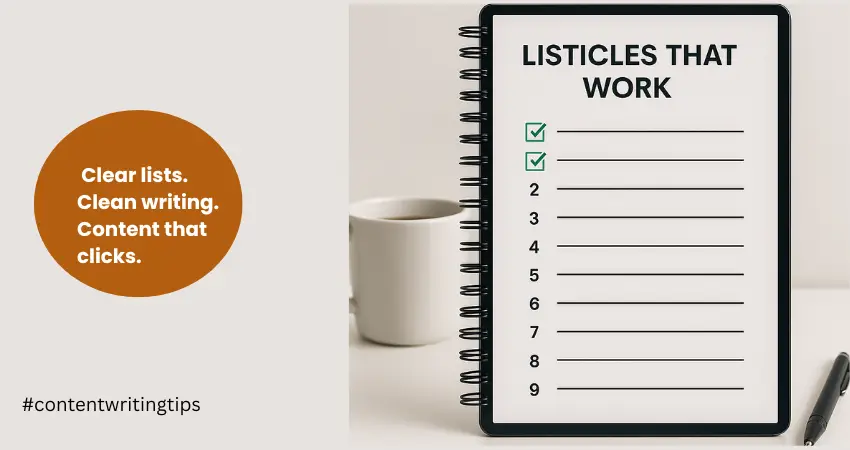
Listicles are popular for a reason. They help readers get the point quickly. Whether it’s “5 Ways to Grow on LinkedIn” or “10 Freelance Writing Tips That Actually Work,” listicles break complex ideas into clear, digestible steps. But writing a good listicle isn’t just about listing things. It’s about structuring your content to add real value — not just take up space on the internet. I’ve written all kinds of blog posts — tutorials, explainers, case studies. But listicles? They’re one of the easiest formats to write well and one of the easiest to mess up. A listicle is more than just a bunch of bullet points. When done right, it gives your reader a clear path, real takeaways, and a reason to keep scrolling. Here’s how to write one that works. Key Takeaways A listicle is a blog post or article structured as a list. Each item should offer practical value — no filler. Use examples, order points logically, and format consistently. A strong title and internal linking improve reach and credibility. Best for readers who prefer skimmable, high-utility content. 1. Make Sure Your Content Makes Sense in a List Format Start with the topic. Ask: Can this be broken into clear, stand-alone points? If yes, it’s a good fit for a listicle. For example, “Tips to Improve Blog Headlines” makes sense as a list — each tip can stand alone but still build toward the goal. But “My Journey as a Writer” doesn’t benefit from being in numbered format. That’s a personal story, not a list. Tip: If you feel the need to keep adding context between list items, it may not be a listicle-worthy topic 2. Include Valuable Takeaways — No Fluff! Every point should offer something useful. Don’t just repeat what everyone else is saying. Ask: What does the reader get out of this? Can they apply it right away? Avoid filler like “Be consistent.” Instead, say how to stay consistent — use a content calendar, write at the same time daily, or batch your posts weekly. If it doesn’t teach, guide, or help, cut it. 3. Link to More In-Depth Information When Necessary Listicles aren’t meant to explain everything in detail. But they should point readers to where they can learn more. Add internal links to your own blogs or trustworthy external sources. Example: If one point in your list says “Use a strong CTA,” link to a full blog that breaks down CTA writing techniques with examples. This not only adds SEO value but keeps your content useful even for advanced readers. 4. Explain List Items Using Relatable Examples People remember examples more than abstract advice. Instead of saying, “Write short sentences,” show a before-and-after version: Before: Despite the fact that it was raining, she still went out. After: It was raining. She still went out. Examples make your advice feel real. They also show that you’ve used the tip yourself or thought it through, which builds credibility. 5. Number Your Items Readers love numbers. They signal structure. And in a sea of content, they help people decide whether they have time to read your post. Odd numbers often perform better (e.g., 7 or 11 instead of 10 or 20), but that’s not a rule. What matters more is that the number matches the value you’re offering. Don’t add fluff just to hit a number. Bonus Tip: Mention the number in the title. Example: “7 Ways to Make Your Writing Stronger” 6. Include an Appropriate Number of List Items Too few, and your post feels incomplete. Too many, and your reader may bounce. For most educational blogs, 6–12 items work best. If you go beyond 15, make sure each item still delivers something new. Repetition weakens trust. Quality always beats quantity. Readers will thank you for cutting what isn’t essential. 7. Use Category Buckets for Longer Lists If your list goes beyond 12–15 items, break them into sections with mini-headings. It gives visual breaks and improves readability. Example: In “21 Tools Every Writer Needs,” you might divide them like this: Writing & Editing Visual & Design SEO & Analytics Category buckets also help you avoid repeating similar tools or tips. 8. Logically Order Each Step There are three ways to order list items: Chronologically (for how-to guides or tutorials) By priority (start with the most impactful) By category (if you’re grouping items) Avoid random order unless it truly doesn’t matter. Structure helps people follow your logic and feel guided — even when skimming. 9. Make Sure Your Listicle Is Consistent Consistency in tone, format, and length improves trust and makes the post easier to read. If one point is a sentence and the next is four paragraphs, it feels jarring. Likewise, switching tone from formal to casual can confuse the reader. Keep sentence structures similar. Start each item with an action verb if you’re giving tips. For example: Avoid jargon Write shorter intros Show, don’t tell 10. Have a Clear and Catchy Title Your title should grab attention without misleading the reader. Start with a number, include your main topic, and hint at the value inside. Examples: “10 Ways to Hook Readers With Your Opening Line” “7 Signs Your Freelance Pitch Needs Work” Avoid vague titles like “Writing Tips You Should Know.” They don’t stand out — and they don’t tell readers what they’ll learn. Final Thought Listicles aren’t lazy writing. When structured right, they deliver focused value, reduce reader fatigue, and boost engagement. They’re a smart format for writers who want to share practical advice without overwhelming their audience. Whether you’re creating content for brands or building your own writing blog, learning to write a clean, useful listicle is a skill worth having. Need help turning your ideas into high-performing content?I write SEO-friendly blog posts, listicles, and web content that connect with real readers — and drive results.Work with me or drop a message to see how I can support your brand’s content goals.
Why MayapillaiWrites.com Feels Different (and Better) Than Most Content Writing Agencies

Let’s be real — finding the right content writing agency today feels like looking for clarity in a fog of buzzwords and filler posts. There are thousands of websites promising “SEO-optimised,” “high-converting,” “engaging” content. But most of them sound the same. They use big words with little depth, and deliver content that feels flat, forgettable, or worse — like it was written by a robot. That’s exactly why I created MayapillaiWrites.com — a space where content gets back to what it’s meant to do: connect, inform, and make an impact. Here’s why it feels different from most content writing agencies out there. 1. It’s Not Just About Words. It’s About Voice Anyone can write 800 words and call it a blog. But content that works — the kind that your audience reads, saves, and remembers — is built around your brand’s voice. At MayapillaiWrites.com, I don’t use templates or AI content dumps. I listen to what you want to say, how your audience speaks, and write in a tone that sounds like you. Whether it’s a homepage rewrite, product page, SEO blog, or a founder’s story — it should feel like it was written by someone who knows your business inside-out. Because I take the time to. 2. You Work With a Real Writer — Not a Layered Team Here, there’s no content manager assigning your project to a junior writer you’ll never speak to. You work directly with me — Maya Pillai. I’ve been writing for over 20 years, with a background in computer applications and deep experience in technology, cybersecurity, business storytelling, and SEO. Every piece of content is either written or reviewed by me before it reaches you. It’s personal, not processed. 3. Human-First, AI Search Optimized SEO-Optimized Content That Performs Let’s talk about search engines. Yes, I understand SEO and AI Optimization search — I’ve helped blogs rank, even in competitive niches. But here’s the difference: I never write for just Google. Your content is crafted to: Be found in search Be enjoyed by people Be remembered for your brand voice That’s what real SEO content writing should do — attract, engage, and retain. 4. It’s Not Just for Clients. It’s a Place for Writers, Too I regularly share: Writing tips that come from real-world experience Free resources and templates Insights on freelancing, branding, and storytelling This is an ecosystem, not just a service. 5. No Gimmicks. No Vanity Metrics. Just Content That Works. You won’t find “limited time offers” or “1,000 words in 24 hours” packages here. What you will find is: Writing that’s clear, clean, and compelling Process that’s collaborative Results that last beyond a post going live Because at the end of the day, good content is about clarity. Not clutter. So, Why Choose MayapillaiWrites.com? Here’s the short version: ✅ 20+ years of experience in content and strategy ✅ Direct, one-on-one collaboration ✅ SEO-optimized but human-first writing ✅ Personalised tone and structured storytelling ✅ Content for both businesses and writers ✅ No fluff. Just results. Let’s Make Your Content Matter Whether you’re building your brand, launching a product, or just need someone who can turn your thoughts into words that work — I’m here. 📌 Visit MayapillaiWrites.com 📌 Check out the blog 📌 Or reach out to start a conversation You bring the ideas. I’ll help bring them to life — one line at a time.
